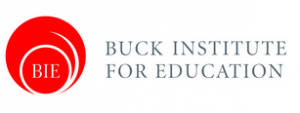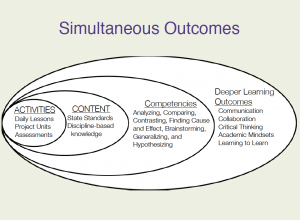A Conversation with Bob Lenz About Project-Based Learning and CBE
CompetencyWorks Blog
 Although I’ve known of the outstanding work of the Buck Institute for Education for over 25 years, I’ve never had a chance to meet the leadership team. Thus, I was delighted to grab an hour with Executive Director Bob Lenz at iNACOL18.
Although I’ve known of the outstanding work of the Buck Institute for Education for over 25 years, I’ve never had a chance to meet the leadership team. Thus, I was delighted to grab an hour with Executive Director Bob Lenz at iNACOL18.
The world of project-based learning (PBL) shares a common challenge with competency-based education (CBE): quality. PBL has been growing its field in a sustained way for decades, with the efforts of the Hewlett deeper learning initiatives bringing an increase of attention. CBE, with roots that stretch back into the 1960s, only started to operate as a field in 2011. In the CBE world, the quality issues are looming so large that it could cause our momentum to buckle.
One of the challenges the field of PBL faces is to get greater clarity on what high quality PBL means in a world where anything that that actively engages students can be called a project or PBL. This has direct implications for schools that are becoming competency-based, as we need to make sure all students have opportunities for deeper learning. A hands-on activity just isn’t the same as deeper learning. Thus, PBL’s quality challenge is our quality challenge.
Below are some of my takeaways from my conversation with Lenz about PBL and its intersection with CBE.
We know that providing opportunities for students to apply their knowledge and skills to real-world problems is important. Some schools are designed around PBL, but for other schools, what is the right amount of PBL to make sure students are developing deeper learning competencies?
Lenz was clear: Two high quality projects per year per student is a solid goal. If every school did that consistently, students would have been involved in twenty-six projects by the time they graduated.
That seems do-able, right?
What is high quality project-based learning?
Many teachers create high engagement activities and call them projects. But this isn’t the same as high quality project-based learning. Over the past two years, a framework for high quality project-based learning was developed by an international group of PBL experts and practitioners, facilitated by the Buck Institute and Getting Smart. There are six criteria to think about:
- INTELLECTUAL CHALLENGE AND ACCOMPLISHMENT: Students learn deeply, think critically, and strive for excellence.
- AUTHENTICITY: Students work on projects that are meaningful and relevant to their culture, their lives, and their future.
- PUBLIC PRODUCT: Students’ work is publicly displayed, discussed, and critiqued.
- COLLABORATION: Students collaborate with other students in person or online and/or receive guidance from adult mentors and experts.
- PROJECT MANAGEMENT: Students use a project management process that enables them to proceed effectively from project initiation to completion.
- REFLECTION: Students reflect on their work and their learning throughout the project.
High quality PBL is designing for simultaneous outcomes. At the center of PBL is the knowledge and skills you want students to develop. In other words, be intentional. Start by clarifying the standards, skills, and dispositions students should be able to demonstrate. That is 100 percent consistent with CBE Quality Principles #10 Seek Intentionality and Alignment and #12 Maximize Transparency.
When you consider these six criteria, it becomes much easier to distinguish between high quality PBL where students are engaged in deeper learning and other types of projects and activities.
Check out High Quality Project-Based Learning website for resources.
How can teachers be supported in moving from high engagement activities toward high quality project-based learning?
Lenz explained that high engagement activities are important for students but not the same as high quality PBL. PBL runs over longer periods of time, and is organized to engage and motivate students while developing higher order skills, dispositions, and opportunities to apply academic knowledge. PBL also takes a different level of planning. Thus, it helps to build up capacity and engage in detailed planning, taking into consideration what supports your students will need to be successful, before launching PBL.
He recommended Bena Kallick’s approach of cognitive coaching to help teachers start where they are and build their capacity to develop activities that offer deeper learning opportunities to students. (See Students at the Center: Personalized Learning with Habits of Mind.)
Teachers can begin by thinking about how to use activities or limited projects to engage students related to one academic domain. Over time, they can begin to add on other pieces related to dispositions such as thinking like a scientist or a historian. As they build capacity, they can then move to authentic, interdisciplinary PBL that is designed around multiple outcomes.
He also cautioned that teachers without in-depth knowledge of academic domains and instructional domain knowledge are likely to have a more difficult time creating higher quality projects. Thus, principals or instructional leaders in schools may want to encourage collaboration so that teachers with greater domain knowledge can coach those who are in more emerging levels.
Equity is at the core of competency education. We are always looking at ways we can repair gaps and ensure that all students are having opportunity for deeper learning. How can we ensure PBL is contributing to closing gaps?
Lenz was emphatic in explaining, “Just implementing Project Based Learning will not close the literacy and numeracy gaps — HQPBL engages students intellect and drives inquiry that requires content knowledge and motivates students to learn to read and use math skills. Teachers still need to use research based strategies to teach reading, writing, and numeracy. If you are going to close gaps then you need to address it directly.” He also said that advisor systems, with no more than 1:15 ratios like the Big Picture Model, can help to guard against inequity since the teachers know their students well and can push for appropriate cognitive demand. Advisors who are engaging with students about their learning can identify early on when there is a need for more support and/or more challenges.
Wherever I go, teachers tell me that math is difficult to integrate into PBL. Is there any way to address this?
Math is hard to integrate into PBL because our math teachers tend to not have deep enough understanding of math and its application in the real world to design high quality PBL. Thus, math tends to get watered down. Another issue is that there are often misalignments between what is needed for effective mathematics instruction and the assessments. Both conceptual understanding and process skills are needed. This means that the focus of instruction moves from making sure students get the right answer to seeking insights into how students are understanding mathematical concepts and the process they are using to solve problems. Are they solving multiplication problems through a sequence of add numbers together or have they memorized the tables? Do they understand that division is the inverse of multiplication or are they simply following the processes? This is often referred to as learning progressions or concept maps that help teachers understand where there are likely places that students need additional support to fully understand concepts and processes within a discipline. (See Achieve’s report for further explanation of learning progressions.)
Not all teachers want to be designers of PBL or curriculum. What is needed for support so that every teacher can offer or participate in PBL opportunities?
Lenz explained that BIE has been considering the research on diffusing innovation. Early adopters and innovators find the design process appealing. However, not everyone has the interest or time to design PBL.
The Buck Institute for Education is starting down a path to create hundreds of model projects that can be used and adapted by teachers.
Stay tuned!
See also:
